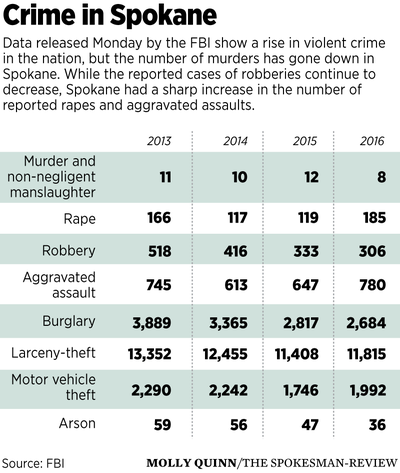FBI numbers show national increase in murders; Spokane reports spike in rapes and assaults

Violent crime in America rose for the second straight year, largely driven by a spike in killings in some major cities, but the crime numbers released Monday by the FBI shows that the worst crimes remained near historically low levels.
In Spokane, the numbers of murders dropped from 12 in 2015 to eight in 2016, but the Lilac City had a big jump in the number of reported rapes (185) and aggravated assaults (780).
As for the national numbers, the Trump administration immediately seized on the figures as proof that the nation is in the midst of a dangerous crime wave that warrants a return to tougher tactics like more arrests and harsher punishments for drug criminals. But criminologists cautioned the new numbers may not indicate the start of a long-term trend, noting that violent crime rates remain well below where they were a quarter-century ago.
Violent crimes such as shootings and robberies rose 4.1 percent in 2016 from the year before, with homicides climbing 8.6 percent, according to the figures. Violence increased 3.9 percent in 2015, while killings jumped by more than 10 percent.
“This is a frightening trend that threatens to erode so much progress that had made our neighborhoods and communities safer – over 30 years declines in crime are being replaced by increases,” Attorney General Jeff Sessions said last week during a speech in Boston. “We cannot accept this as the new normal.”
Still, the FBI said it was the first time violent crime rose in consecutive years in more than a decade.
The report showed there were an estimated 1.2 million violent crimes in the U.S. last year. Though the violent crime numbers rose from 2015 to 2016, the five-year and 10-year trends show an increase from 2012 (up 2.6 percent) and a decrease from 2007 (down 12.3 percent).
Despite that, Sessions called upon law enforcement to “confront and turn back the rising tide of violent crime.” Sessions has used the threat of rising violence as an impetus for many of his sweeping policy changes. He has directed the nation’s federal prosecutors to seek tougher sentences against most suspects, including some low level drug offenders, and has urged them to focus more intensely on prosecuting gun cases.
Sessions has also been a proponent of the theory that crime has risen as scrutiny of local police has intensified and hurt morale, causing officers to be less aggressive on the streets. As such, he has worked to support the interests of some of the nation’s largest police unions.
But experts remain divided about what caused the rise and about how to respond. Some criminologists believe community distrust in police has made residents less likely to cooperate in investigations, driving up crime.
Two years’ worth of data is not enough to show a trend, said Adam Gelb, director of the Public Safety Performance Project of The Pew Charitable Trusts.
“There just aren’t any factors that would strongly indicate continued further increases,” he said. “We all yearn for a big-picture, national explanation for what’s going on that would help us make sense of this, but we don’t have one.”
In Washington state, the rate of murders was down 10.6 percent in 2016 from the year before while all violent crime climbed 7.4 percent. The number of rapes statewide was up 12.6 percent as was the number aggravated assaults (8.6 percent).
Idaho’s violent crime reports went up 7.9 percent and the murder rate jumped 53.1 percent (49 in 2016 versus 32 in 2015). However, the Gem State also showed increases across the board in all crime categories.
In Spokane, the reported robberies fell to a four-year low of 306 cases. But the number of aggravated assaults in 2016 spiked to 780 compared to 647 the year before. The number of rapes also jumped to 185 last year compared to 119 in 2015.
However all the news was not bad as the number of burglaries dropped to 2,648 compared to 2,817 in 2015, and arson dropped from 47 to 36 cases in 2016. But reported car thefts climbed to 1,992 last year, which was 246 more cases than the previous year.
Despite the national increase in crime, the violent crime rate in 2016 was still down significantly from several years ago. It dropped 18 percent from 2007, and the murder rate was 6 percent lower than it was the same year, according to the data. And it was far from the levels of the 1980s and 1990s, during the height of the drug war, when Sessions was a federal prosecutor in Mobile, Alabama.
Some big cities saw increases in violence while others did not. Chicago, for example, singled out by the White House for its surge in shootings, saw a 60 percent jump in killings from 2015, accounting for more than 20 percent of the nation’s increase in murders, according to an analysis of the FBI data by the Brennan Center for Justice at New York University. It found 11 major cities were responsible for driving up the national murder rate.
Reporter Thomas Clouse contributed to this report